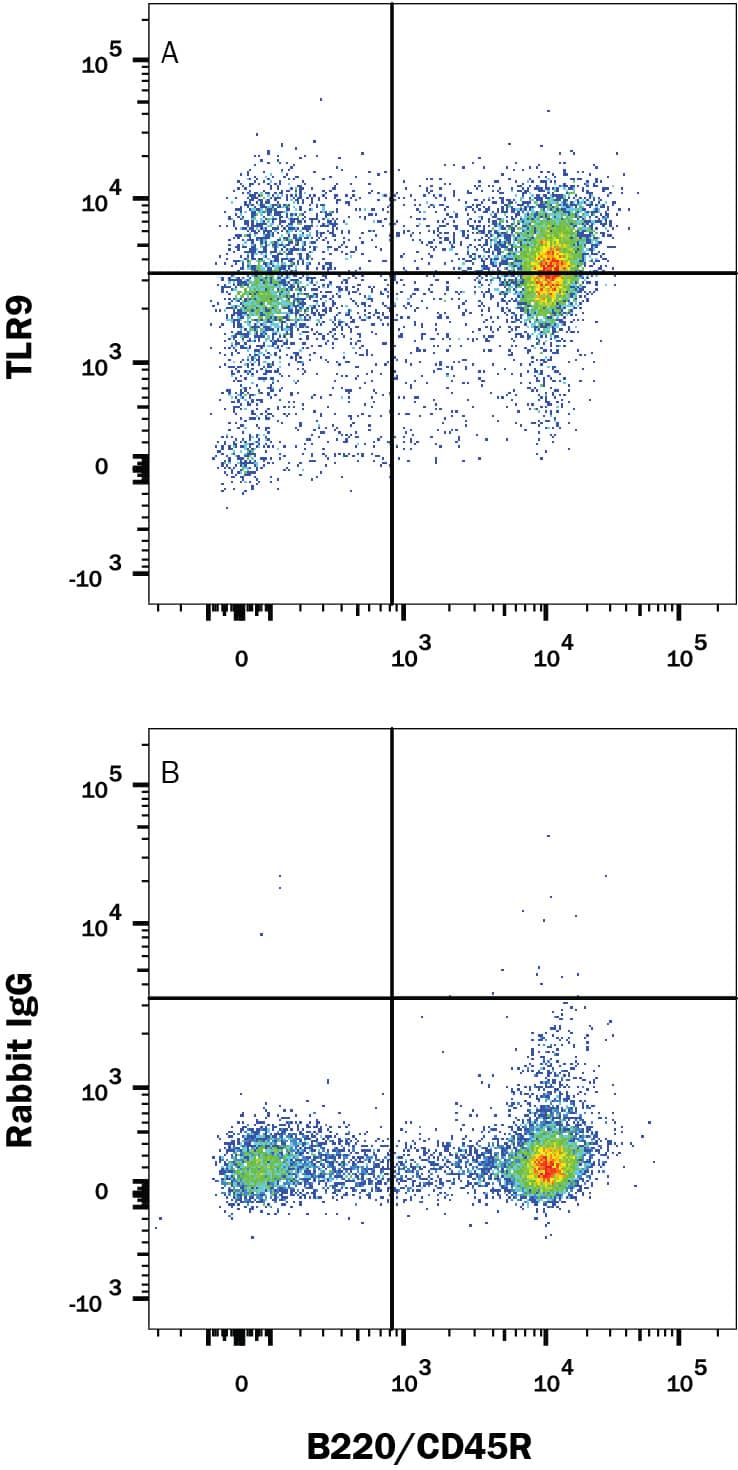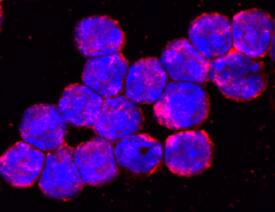Mouse TLR9 Antibody
R&D Systems, part of Bio-Techne | Catalog # MAB7960


Key Product Details
Species Reactivity
Applications
Label
Antibody Source
Product Specifications
Immunogen
Leu26-Asp818
Accession # AAK29625
Specificity
Clonality
Host
Isotype
Scientific Data Images for Mouse TLR9 Antibody
Detection of TLR9 in Mouse Splenocytes by Flow Cytometry.
Mouse splenocytes were stained with Rat Anti-Mouse B220/CD45R APC-conjugated Monoclonal Antibody (Catalog # FAB1217A) and either (A) Rabbit Anti-Mouse TLR9 Monoclonal Antibody (Catalog # MAB7960) or (B) Normal Rabbit IgG Control (Catalog # AB-105-C) followed by Phycoerythrin-conjugated Anti-Rabbit IgG Secondary Antibody (Catalog # F0110). To facilitate intracellular staining, cells were fixed and permeabilized with FlowX FoxP3 Fixation & Permeabilization Buffer Kit (Catalog # FC012). View our protocol for Staining Intracellular Molecules.TLR9 in Mouse Splenocytes.
TLR9 was detected in immersion fixed mouse splenocytes using Rabbit Anti-Mouse TLR9 Monoclonal Antibody (Catalog # MAB7960) at 0.5 µg/mL for 3 hours at room temperature. Cells were stained using the NorthernLights™ 557-conjugated Anti-Rabbit IgG Secondary Antibody (red; Catalog # NL004) and counterstained with DAPI (blue). Specific staining was localized to cell surfaces and cytoplasm. View our protocol for Fluorescent ICC Staining of Non-adherent Cells.Applications for Mouse TLR9 Antibody
Immunocytochemistry
Sample: Immersion fixed mouse splenocytes
Intracellular Staining by Flow Cytometry
Sample: Mouse splenocytes fixed and permeabilized with FlowX FoxP3 Fixation & Permeabilization Buffer Kit (Catalog # FC012)
Formulation, Preparation, and Storage
Purification
Reconstitution
Formulation
Shipping
Stability & Storage
- 12 months from date of receipt, -20 to -70 °C as supplied.
- 1 month, 2 to 8 °C under sterile conditions after reconstitution.
- 6 months, -20 to -70 °C under sterile conditions after reconstitution.
Background: TLR9
TLR9 (Toll‑like receptor 9), designated CD289, is a member of the TLR family of innate immune receptors that is mainly expressed by colonic epithelium, CD123+ plasmacytoid predendritic cells (pDC), and splenic transitional B cells (1‑9). TLR9 responds to unmethylated DNA CpG motifs that occur mainly in bacteria and viruses (1, 2). Mouse TLR9 cDNA encodes a 1032 amino acid (aa) type I transmembrane glycoprotein with a 793 aa extracellular domain (ECD) that contains 26 leucine‑rich repeats (LRRs, aa 26‑818), and a 193 aa cytoplasmic domain with a TIR sequence that dimerizes with signaling adaptors such as MyD88 (1). The mouse TLR9 ECD shares 87% aa sequence identity with rat and 71‑74% with human, feline, canine, equine, porcine, bovine and ovine TLR9. Predicted splice forms vary at the N‑terminus by initiating either upstream or downstream of the standard site. The full-length 150 kDa form, which is ligand‑binding but nonsignaling, is found in the endoplasmic reticulum. It undergoes accessory protein-mediated translocation either to the cell membrane or to lysosomes (1‑3). TLR9 is cleaved to remove LRR1‑14, producing an 80 kDa signaling fragment within acidic endolysosomes where it encounters microbial CpG DNA rather than self-DNA (2, 10, 11). However, immune complexes of self‑DNA with lupus erythematosus anti‑DNA antibodies can induce TLR9 activation and IFN‑ alpha production in pDC (4). A soluble form also found in endosomes includes all 26 LRRs and negatively regulates active TLR9 (12). Activation of TLR9 contributes to splenocyte proliferation, pDC maturation, macrophage inflammatory cytokine production, Th1 inflammatory responses, NK cell activation and recruitment, B cell surface MHC class II up‑regulation and immunoglobulin production, and generation and maintenance of memory B cells (1, 5‑9).
References
- Hemmi, H. et al. (2000) Nature 408:740.
- Barton, G.M. et al. (2006) Nat. Immunol. 7:49.
- Latz, E. et al. (2004) Nat. Immunol. 5:190.
- Barrat, F.J. et al. (2005) J. Exp. Med. 202:1131.
- Krieg, A.M. et al. (1995) Nature 374:546.
- Aranburu, A. et al. (2010) J. Immunol. 185:7293.
- Guerrier, T. et al. (2012) J. Autoimmun. 39:173.
- Guillerey, C. et al. (2012) Blood 120:90.
- Cunningham-Rundles, C. et al. (2006) J. Immunol. 176:1978.
- Ewald, S.E. et al. (2008) Nature 456:658.
- Park, B. et al. (2008) Nat. Immunol. 9:1407.
- Chockalingam, A. et al. (2011) Eur. J. Immunol. 41:2176.
Long Name
Alternate Names
Gene Symbol
UniProt
Additional TLR9 Products
Product Documents for Mouse TLR9 Antibody
Product Specific Notices for Mouse TLR9 Antibody
For research use only
